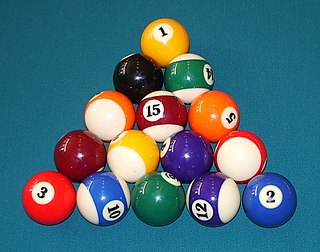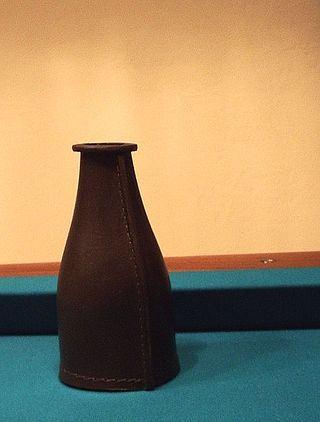
Cue sports are a wide variety of games of skill played with a cue, which is used to strike billiard balls and thereby cause them to move around a cloth-covered table bounded by elastic bumpers known as cushions.

Eight-ball is a discipline of pool played on a billiard table with six pockets, cue sticks, and sixteen billiard balls. The object balls include seven solid-colored balls numbered 1 through 7, seven striped balls numbered 9 through 15, and the black 8 ball. After the balls are scattered with a break shot, a player is assigned either the group of solid or striped balls once they have legally pocketed a ball from that group. The object of the game is to legally pocket the 8-ball in a "called" pocket, which can only be done after all of the balls from a player's assigned group have been cleared from the table.

Nine-ball is a discipline of the cue sport pool. The game's origins are traceable to the 1920s in the United States. It is played on a rectangular billiard table with pockets at each of the four corners and in the middle of each long side. Using a cue stick, players must strike the white cue ball to pocket nine colored billiard balls, hitting them in ascending numerical order. An individual game is won by the player pocketing the 9-ball. Matches are usually played as a race to a set number of racks, with the player who reaches the set number winning the match.

English billiards, called simply billiards in the United Kingdom and in many former British colonies, is a cue sport that combines the aspects of carom billiards and pool. Two cue balls and a red object ball are used. Each player or team uses a different cue ball. It is played on a billiards table with the same dimensions as one used for snooker and points are scored for cannons and pocketing the balls.

Straight pool, which is also called 14.1 continuous and 14.1 rack, is a cue sport in which two competing players attempt to pot as many billiard balls as possible without playing a foul. The game was the primary version of pool played in professional competition until it was superseded by faster-playing games like nine-ball and eight-ball in the 1980s.
Golf billiards is a pocket billiards game usually played for money. Unlike the majority of such games, it allows more than two people to play without compromises or rule changes. The game borrows from the outdoor game of golf, which is historically related to the cue sports. It is usually played on 10-foot or 12-foot snooker tables as their size and structure are more appropriate. In 2006 the Billiard Congress of America commented it was more popular than snooker in the United States.
Cutthroat or cut-throat, also sometimes referred to as three-man-screw, is a typically three-player or team pocket billiards game, played on a pool table, with a full standard set of pool balls ; the game cannot be played with three or more players with an unnumbered reds-and-yellows ball set, as used in blackball. Each player is commonly assigned a set of five consecutively numbered object balls, though the number of balls will vary by number of players. The object of the game is to be the last player with at least one ball of their group remaining on the table.

Russian pyramid, also known as Russian billiards, is a form of billiards played on a large billiard table with narrow pockets. It is popular across Eastern Europe as well as countries of the former Soviet Union/Eastern Bloc. In Western countries, the game is known as pyramid billiards, or simply pyramid within professional circles.

A billiard table or billiards table is a bounded table on which cue sports are played. In the modern era, all billiards tables provide a flat surface usually made of quarried slate, that is covered with cloth, and surrounded by vulcanized rubber cushions, with the whole thing elevated above the floor. More specific terms are used for specific sports, such as snooker table and pool table, and different-sized billiard balls are used on these table types. An obsolete term is billiard board, used in the 16th and 17th centuries.

Ten-ball is a rotation pool game similar to nine-ball, but using ten balls instead of nine, and with the 10 ball instead of the 9 as the "money ball"
The following is a glossary of traditional English-language terms used in the three overarching cue sports disciplines: carom billiards referring to the various carom games played on a billiard table without pockets; pool, which denotes a host of games played on a table with six pockets; and snooker, played on a large pocket table, and which has a sport culture unto itself distinct from pool. There are also games such as English billiards that include aspects of multiple disciplines.

Rotation, sometimes called rotation pool, 15-ball rotation, or 61, is a pool game, played with a pocketed billiards table, cue ball, and triangular rack of fifteen billiard balls, in which the lowest-numbered object ball on the table must be always struck by the cue ball first, to attempt to pocket numbered balls for points.

Three-ball is a folk game of pool played with any three standard pool object balls and cue ball. The game is frequently gambled upon. The goal is to pocket the three object balls in as few shots as possible. The game involves a somewhat more significant amount of luck than either nine-ball or eight-ball, because of the disproportionate value of pocketing balls on the break shot and increased difficulty of doing so. In some areas and subcultures, such as the Asian-American youth-dominated pool hall scene of San Francisco, California, three-ball is a popular local tournament game.
Honolulu, also known as banks, kisses, and combinations or indirect, is a pocket billiards game. Players must pocket all shots in an indirect fashion to reach a set number of points. The game shares some similarities with other cue sports, played on tables and with balls used for pool, but differs with foul points being awarded for regular direct shots.

Snooker is a cue sport that is played on a baize-covered table with pockets in each of the four corners and in the middle of each of the long side cushions. It is played using a cue and snooker balls: one white cue ball, 15 red balls worth one point each, and six balls of different colours: yellow, green (3), brown (4), blue (5), pink (6), black (7). A player wins a frame of snooker by scoring more points than the opponent(s), using the cue ball to pot the red and coloured balls. A player wins a match when they have achieved the best-of score from a pre-determined number of frames. The number of frames is always odd so as to prevent a tie or a draw.

Baseball pocket billiards or baseball pool is a pocket billiards (pool) game suitable for multiple players that borrows phraseology and even some aspects of form from the game of baseball. For instance, although baseball pool is played on a standard pool table, the 9 ball is known as the "pitcher", the table's foot spot where balls are racked is known as "home plate", and each team or player is afforded "nine innings" to score as many "runs" as possible.

Bottle pool, also known as bottle-billiards and bottle pocket billiards, is a hybrid billiards game combining aspects of both carom billiards and pocket billiards. Played on a standard pool table, the game uses just two object balls, a cue ball, and a 6+3⁄4 inches (170 mm) tall, narrow-necked bottle called a shake bottle or tally bottle, traditionally made from leather, that is placed on the table and used as a target for caroms. Those unfamiliar with the game sometimes mistakenly use its name as a synonym for the very different game of kelly pool. Bottle pool has been described as combining "elements of billiards, straight pool and chess under a set of rules that lavishly rewards strategic shot making and punishes mistakes with Sisyphean point reversals."

Cribbage, sometimes called cribbage pool, fifteen points and pair pool, is a two-player pool game that, like its namesake card game, has a scoring system which awards points for pairing groups of balls that total 15. Played on a standard pool table, participants who pocket a ball of a particular number are required to immediately pocket the companion ball that tallies to 15 when added to the prior ball's number. Each pair so pocketed counts as a cribbage; there are seven such pairs, and the 15 ball counts as an eighth by itself after all of the others have been pocketed. The first player to score five cribbages wins the game.
Carom billiards and pool are two types of cue sports or billiards-family games, which as a general class are played with a stick called a cue which is used to strike billiard balls, moving them around a cloth-covered billiard table bounded by rubber cushions attached to the confining rails of the table.

Fifteen-ball pool, also known as sixty-one pool, is a pocket billiards game developed in America in the nineteenth century from pyramid pool. Created by members of the Bassford's Billiard & Chess Rooms in Manhattan during the late 1830s or 1840s, it is the ancestor to many American pool games.



















